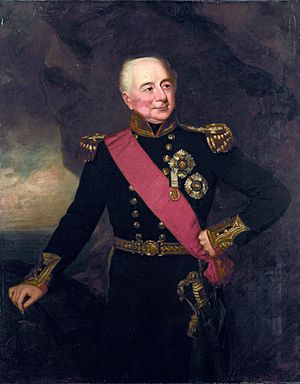William Hargood facts for kids
Quick facts for kids
Sir William Hargood
|
|
|---|---|

Sir William Hargood
|
|
| Born | 6 May 1762 |
| Died | 12 December 1839 (aged 77) Bath, Somerset |
| Allegiance | |
| Service/ |
|
| Rank | Admiral of the White |
| Commands held | Plymouth Station |
| Battles/wars | American War of Independence French Revolutionary War Napoleonic Wars |
| Awards | Knight Commander of the Order of the Bath Knight Grand Cross of the Royal Guelphic Order |
| Signature | |
Admiral of the White Sir William Hargood (6 May 1762 – 12 December 1839) was a brave British naval officer. He served in important wars like the American War of Independence, the French Revolutionary War, and the Napoleonic Wars. He was known for having some bad luck, but this changed after his courageous actions at the battle of Trafalgar. There, he commanded the ship HMS Belleisle.
Contents
William Hargood was born in 1762 into a family connected to the Royal Navy. His father worked at a naval dockyard. This helped William get a job as a midshipman (a junior officer in training) on HMS Triumph in 1775.
First Voyages and Battles
On HMS Triumph, he sailed with a group of ships (a convoy) to Newfoundland. The next year, he moved to HMS Bristol. With this ship, he traveled to the West Indies and the American coast. He was involved in a landing at Fort Moultrie in 1776 during the American War of Independence.
By 1781, Hargood was a lieutenant. He served on a small warship called HMS Port Royal. He tried his best to keep supplies flowing to Pensacola, but the city fell to the Spanish. In 1782, he was on HMS Magnificent during the battle of the Saintes.
Friendship with a Future King
After the war, Hargood stayed in American waters. There, he met Captain William Henry, who would later become King of the United Kingdom in 1830. They became very good friends. William Henry made Hargood his first lieutenant on the fast warship frigate HMS Pegasus. Later, Hargood joined him on HMS Andromeda.
In 1789, William Henry helped Hargood get promoted to commander. He was given command of a small warship, HMS Swallow, and sailed off Ireland for a year. After that, he moved to HMS Hyaena in the West Indies. There, he was promoted again to Post Captain, which meant he could command a larger ship.
Challenges and the Battle of Trafalgar
In 1793, Hargood and his ship were captured by the French. He was later exchanged and cleared of any wrongdoing. In 1796, he was given command of HMS Leopard. This command ended badly when he was forced off his ship during the Spithead mutiny, a protest by sailors.
Voyage to China and the Macau Incident
After this, Hargood commanded HMS Nassau and then HMS Intrepid. He led a group of merchant ships, called East Indiamen, all the way to China. He stayed there until 1803, defending Macau during the Macau Incident in January 1799.
Joining Nelson's Fleet
When war broke out again, Hargood was given command of the ship of the line HMS Belleisle. This was a good ship that the British had captured from the French in 1795. Hargood joined Admiral Nelson's fleet in the Mediterranean Sea. He took part in the long chase across the Atlantic Ocean. His ship was so worn out that it needed repairs at Plymouth. Belleisle only rejoined the fleet two weeks before the famous battle of Trafalgar on October 21.
Heroism at Trafalgar
During the Battle of Trafalgar, Belleisle was the second ship in Admiral Collingwood's group. It followed the lead ship, HMS Royal Sovereign, into the enemy lines. Belleisle waited to fire until it could shoot cannons from both sides at once into the French ship Fougueux and the Spanish ship Santa Ana.
Belleisle fought continuously, often alone against many enemy ships. Eventually, it attacked the Spanish ship Argonauta. Belleisle managed to capture Argonauta, but not before its own masts were broken. Belleisle suffered many injuries, with 33 sailors dead and 93 wounded, including Hargood himself. He was badly bruised by the cannon fire.
Belleisle was lucky to survive the storm that followed the battle. Only with the constant help of the frigate HMS Naiad was it slowly towed back to Gibraltar.
Later Life and Legacy
After the Battle of Trafalgar, Hargood, who had struggled to get good commands before, was suddenly offered many opportunities. After some profitable jobs on shore, he was made a rear-admiral. He was given command of the Channel Islands squadron, which carried out many raids on the French coast and earned a lot of money from captured enemy ships (prize money).
In 1811, he married Maria Cocks. They lived happily together until his death. After the war ended in 1815, Hargood retired from active sea duty. However, he continued to hold important shore jobs.
Retirement and Honors
In the 24 years between his retirement and his death, he received many honors. He was made a vice admiral, a Knight Grand Cross of the Order of the Bath, and a Knight Grand Cross of the Royal Guelphic Order. He also became a full Admiral of the White and Commander-in-Chief, Plymouth.
Throughout his life, he remained close friends with William Henry, even after William became King William IV in 1830. Sir William Hargood retired to Bath, living at 9 Royal Crescent. He died there and was buried in Bath Abbey. You can still see his tombstone and a long message about his life on a wall plaque there.

